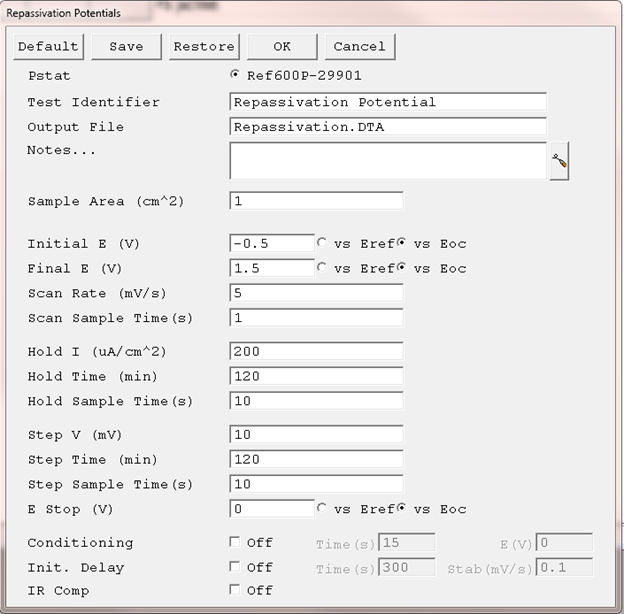THE Repassivation Potential Parameters
Here is a THE Repassivation Potential Setup dialog box with its default parameters.

Starting point for the potential sweep during data-acquisition. The allowed range is ±10 volts with a resolution of 1/8 mV. Its accuracy depends on the setting.
Ending point for the potential sweep during data-acquisition. The allowed range is ±10 volts with a resolution of 1/8 mV. Its accuracy depends on the setting.
Speed of the potential sweep during data-acquisition.The Scan Rate is entered in units of mV/s. A practical upper bound on the Scan Rate is 1 mV/s. Higher Scan Rates may run, but yield unreliable data because the potentiostat’s compensation and filtering are set for long time constants. Custom scripts may allow Scan Rates of 1 V/s or more.A lower bound on the Scan Rate is given by the minimum Step Size divided by the longest Sample Period. For scans shorter than 2 V, the slowest Scan Rate is 52.1 nV/s or 0.1875 mV/hour. Multiply these limits by four for scans longer than 2 V.
Duration of the scan. Hold I The current level at which the Simulation Phase ramp is terminated and the current level during the galvanostatic portion of Stimulation. Hold Time The duration of the galvanostatic portion of Stimulation. Hold Sample Time The data density during the Galvanostatic portion of Stimulation. Step V The increment in potential preceding each measurement curve in the Repassivation phase of the test. Step Time The duration of each potential step and its associated current-versus-time curve. Step Sample Time The data density during the Repassivation phase current-versus-time curves. E Stop The final potential in the Repassivation phase of the test.

Comments are closed.